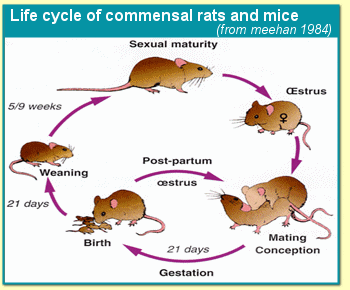Mice Removal Experts of Minneapolis and St. Paul Minnesota
The house mouse (Mus musculus) is by far the most common mammal on earth. Native to central Asia, the mouse arrived in North America with the first European colonists. Mice can now be found all across North America, in every state including coastal Alaska, and in all but northernmost Canada.
- They have large, scantily haired ears; small black protruding eyes; a slightly pointed nose; and rows of scale ringing their long, tapered,
 sparsely furred tail.
sparsely furred tail. - Their life span is 9-18 months, although some have lived up to two years in captivity.
- They usually have light brown to gray or black fur, with white or buff fur underneath.
- The adult mouse has a small slender body weighing from 1/2-ounce to an ounce. The mouse is very adaptable. It’s an excellent swimmer, runner, climber and jumper.
It can jump as high as 12 inches. Mice have excellent senses of smell, taste and touch. While they have poor eyesight, mice have good peripheral vision that allows them to detect movement. Outdoors, mice nest in weeds, rubbish, cracks in rocks or walls, or they will construct a network of tunnels below ground, with chambers for nests and storage, and several exits.
Each fall, the onset of cold weather causes mice to search for food and shelter. Mice are curious, and will enter any hole or crack as small as ¼-inch. If they like what they find inside better than what they had outside, you will have a mouse problem. Mice will nest in any hidden area near a source of food. Their nests are constructed of rags or paper lined with finely shredded material, and look like a loosely woven ball 4-6 inches in diameter.
If food is available, a mouse will normally travel no more than 10-50 feet from their nest. Mice are territorial, and will constantly explore to learn more about their surroundings. They memorize pathways, obstacles, food, water, shelter and other elements in their habitat. They are quick to detect new objects in their environment, and they are more curious than fearful of anything new.
Because of their poor eyesight, mice navigate using their whiskers, usually traveling along a wall or other object. If you don’t move, a mouse can’t see you. They will explore when they think they’re alone…usually at night, but any other time when they don’t detect movement. People usually see mice only when they have been sitting stock still, such as when reading or watching television. Unlike rats, the fact that you have seen a mouse does not necessarily mean they have a high population density.
A mouse family will include a dominant male, several females, and their young. Females will establish a loose hierarchy within their territory. Adult mice will force their young to disperse, although some females may remain close to their parents. The mouse is one of the most prolific of mammals.
- Female mice begin breeding at 40-45 days of age
- Gestation is as short as 18 days, and a litter is 3-12 pups (the average is 5 or 6)
- Female mice produce 12 or more litters per year.
- Newborn mice have no fur and are blind. But they grow rapidly. In 2-3 weeks they are covered with hair and their eyes and ears are open. At 3 weeks, pups begin making short excursions from the nest, and start eating solid food.
It’s easy to see why mouse populations can grow under the right conditions. Fortunately, breeding slows markedly as mouse population’s increase. While they will drink water when it’s available, mice can live in a dry habitat, getting all the water they need from the food they eat. In the wild, mice eat seeds, roots, leaves and stems, beetle larvae, caterpillars, cockroaches, and carrion, but they prefer seeds and grain.
Although mice can live on crumbs, typically they eat 3 grams of food per day (10-15% of their body weight), or about 8 pounds per year. When human food is available, those foods high in fat, protein, or sugar are often eaten in preference to seeds and grain. Some of their favorite human foods include bacon, chocolate, butter and nuts. Mice are naturally curious, and do not hesitate to sample new foods. They will even eat glue or soap, if the soap contains animal fat.
Mice nibble whatever food is available, eating small portions to find what they like best. In this manner, mice destroy much more food than they eat. In a year, one mouse will produce approximately 18,000 fecal droppings. They will store food, which can lead to insect infestations. Though it is not their preference, mice will live in freezers feeding only on frozen food. This usually occurs in large commercial operations that have walk-in coolers.
For more information or to schedule an appointment for an inspection please give Minnesota Wild Management a call. They are trained to prevent, eliminating and controlling mice and rodent problems. Homeowner’s try and tackle this by themselves is real hard to do and usually not successful.





